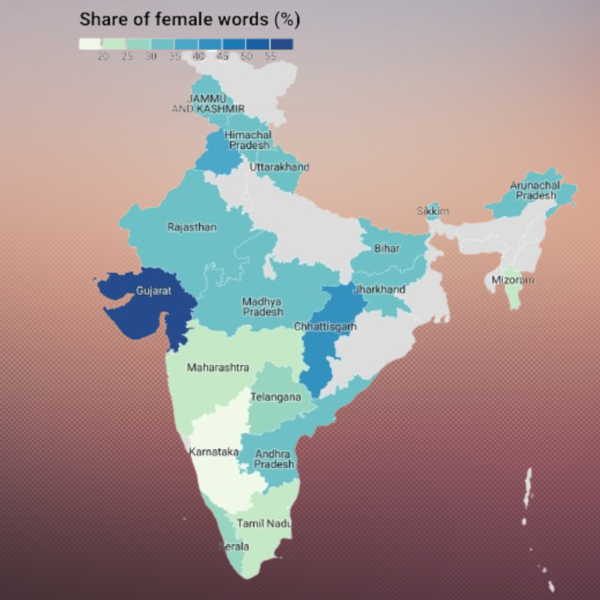The analysis, which examined textbooks printed within the English language, uncovered a troubling development the place male-gendered phrases and stereotypes dominated the narrative. As an example, moms have been continuously related to home duties like cooking, whereas professions comparable to docs have been constantly depicted as male. Regardless of earlier efforts to deal with these points, comparable to a 2017 name for reform by India’s training minister, the research discovered little enchancment, particularly in NCERT textbooks which have undergone revisions as just lately as 2020.
Disparities in gender illustration: A comparability of Indian states
One of many research’s most revealing elements was the variation in gender illustration throughout completely different states. The analysis discovered that Gujarat carried out the most effective by way of feminine illustration, with near 60% of gendered phrases being feminine. In stark distinction, Karnataka fared the worst, with lower than 20% of its gendered phrases representing girls. Surprisingly, this imbalance was most pronounced in southern states, together with Karnataka and Kerala, which historically rating greater on progressive gender indices comparable to feminine literacy and workforce participation.
The desk shows the depend of textbooks per grade throughout varied states. The info contains textbooks from state boards and NCERT Books. NCERT textbooks are chosen by state boards in Arunachal Pradesh, Bihar, Himachal Pradesh, Jammu & Kashmir, Jharkhand, Madhya Pradesh, Rajasthan, Sikkim, and Uttarakhand. The topics coated embody STEM, social sciences, humanities, and sensible/utilized sciences.
This disparity raises questions concerning the affect of state-level instructional insurance policies and the effectiveness of efforts to deal with gender bias. For instance, regardless of Kerala’s ongoing efforts to take away gender stereotypes from textbooks, prompted by considerations over home abuse, its efficiency within the research stays disappointing.
In the meantime, Maharashtra, India’s second most populous state and residential to the monetary capital, Mumbai, is at present present process curriculum revisions. Whereas criticisms have primarily targeted on the shortage of illustration of socioeconomic range, the research underlines that gender illustration can be a serious concern. Maharashtra’s textbooks rank among the many lowest by way of feminine illustration, additional highlighting the necessity for complete reform.
In one other occasion, earlier this yr, Delhi’s State Council of Academic Analysis and Coaching (SCERT) has made vital revisions to high school textbooks after conducting a complete gender audit of 53 textbooks and curricula. The audit, led by a committee of consultants from NCERT, Delhi College, central training institutes, and NGOs, uncovered widespread gender biases. These included male-dominated content material, portrayals of girls in submissive roles, and an absence of illustration for transgender people.
Learn full report | SCERT Audit Reveals Gender Bias in Delhi Textbooks, Proposes Neutral Alternatives for 10 Terms
Gender bias in relation to societal attitudes
One other intriguing discovering of the research is the obvious lack of correlation between the progressive gender norms of a state’s society and the gender bias in its instructional supplies. The analysis cross-referenced textbook content material with a 2022 Pew Survey on gender norms, which measured societal attitudes throughout varied states. Mizoram, for instance, ranked excessive by way of progressive gender views however confirmed solely 22% feminine illustration in its textbooks. Conversely, Gujarat, which carried out the most effective by way of textbook illustration, scored poorly on progressive gender attitudes.
This inconsistency means that gender illustration in instructional supplies doesn’t essentially mirror the prevailing gender norms in society. In some states, progressive societal attitudes in the direction of gender haven’t translated into extra balanced representations of women and men in textbooks. This disconnect underscores the significance of focused coverage interventions to deal with the gender bias that persists in instructional sources, no matter broader social developments.

The info is derived from a current evaluation by the Middle for International Growth (CGD) of state textbooks, using a technique just like that employed within the cross-country evaluation performed by Crawfurd, Saintis-Miller, and Todd (2024). Be aware that the map of India is representational, and is taken from unique research report.
India’s efficiency within the World Financial Discussion board’s Gender Hole Index 2024
The gender bias current in Indian textbooks is a part of a broader nationwide context the place gender inequality stays a pervasive problem. In line with the World Financial Discussion board’s Gender Hole Index 2024, India ranks 129th globally by way of gender parity, inserting it among the many worst-performing nations. The entrenched stereotypes and underrepresentation of girls in instructional supplies mirror and reinforce the broader societal challenges that contribute to this rating.
Moreover, the research positions India, and South Asia extra broadly, because the worst area within the English-speaking world in terms of gender stereotypes in instructional supplies. In comparison with textbooks from the UK, US, Australia, and Sub-Saharan Africa, Indian textbooks display a stronger male bias by way of language associated to achievement and work, whereas feminine figures are disproportionately related to look and home roles. This male-dominant narrative in textbooks not solely limits the aspirations of younger ladies but additionally perpetuates outdated gender roles for all college students.
Transferring ahead: The necessity for reform
The research emphasises the crucial have to reform Indian college textbooks to eradicate gender biases. Whereas states comparable to Kerala have taken steps to eradicate stereotypes, extra efforts are wanted to make sure equal illustration for women and men. Past the numbers, biased language in textbooks influences college students’ perceptions and vanity. To make vital progress, each nationwide and state policymakers should prioritise eradicating gender bias and updating content material. Moreover, selling gender equality in textbooks is crucial in shaping societal attitudes, permitting India to shut the gender hole and transfer in the direction of a extra equitable future.
Learn the total report here- Analysing Gender Bias in School Textbooks in India



